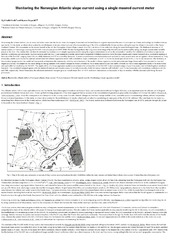| dc.description.abstract | Monitoring the Atlantic inflow (AI) of warm and saline water into the Nordic Seas (Norwegian, Greenland and Iceland Seas) is of great importance becauce of its impact on climate and ecology in Northern Europe and Arctic. In this study, an observation system for establishment of simple, robust and cost effective monitoring of the AI is validated in the Svinøy section, cutting through the AI just to the north of the Faroe-Shetland Channel. We concentrate on the eastern branch of the AI, the Norwegian Atlantic Slope Current (NwASC), an about 40km wide flow along the steep Norwegian slope. The database is an array of 15 current meters on 4 moorings covering the NwASC over a 2-year period 1998–2000. We test the hypothesis that long-term monitoring of the NwASC can be performed by using one single current meter suitable placed in the flow. The volume flux can then be estimated by construction of simple regression models using the single current meter record as the independent variable. For validation of statistical properties as stability, confidence and stationarity, the time series is split into two 1-year segments: a model period and a test period. Gridded correlation fields between currents and volume transport show correlation maxima in the core of the NwASC, ranging from 0.84 on a daily timescale to 0.97 on a monthly timescale. A more comprehensive correlation/ coherence analysis for each current meter record against volume transport on 7-day timescales, enable us to choose the optimal current meter for a linear regression model with (correlation, slope) coefficients of (0.87, 0.13) for the model period and (0.80, 0.13) for the test period. The similarity of the statistical properties for the model and test periods substantiates the stationarity, stability and robustness of the model. A linear regression model underestimates large fluxes and is thus extended to a second degree polynomia. This improves the curve fitting for strong currents with a minor increase in overall correlation, but is more sensistive and less stable. Overall, we find a linear regression model to be more robust and applicable for monitoring the NwASC. The applicability of a linear regression model as an estimator for volume flux of the NwASC is demonstrated using a 2-year time series, and validated against calculated transport. The calculated transport agrees with the statistical analysis and reveals a noisy fit on daily timescale, while the curves coincide well on both 7- and 30-day timescales with correlation coefficients of 0.84 and 0.86, respectively. On all timescales, the calculated and model transport give an overall mean flow of 4.4 Sv and show fluctuations on timescales of days to months, with the seasonal cycle being the most prominent. | en_US |
